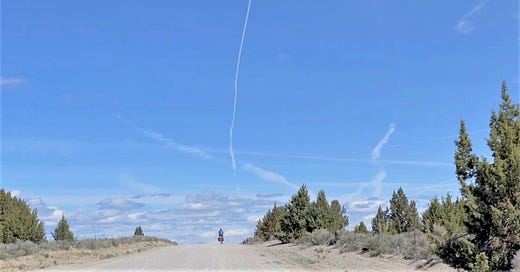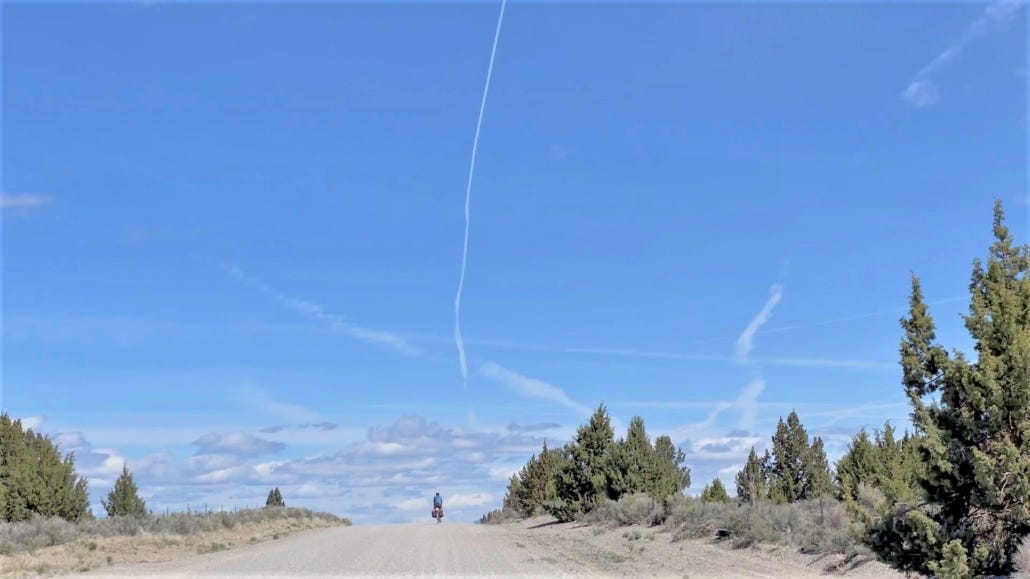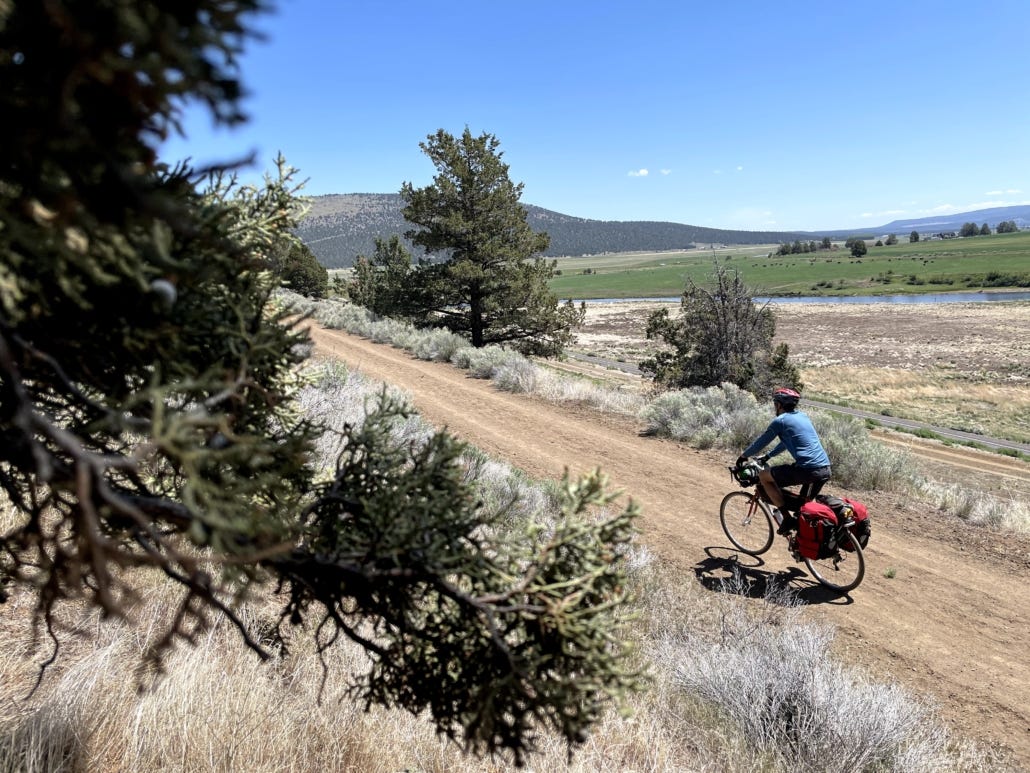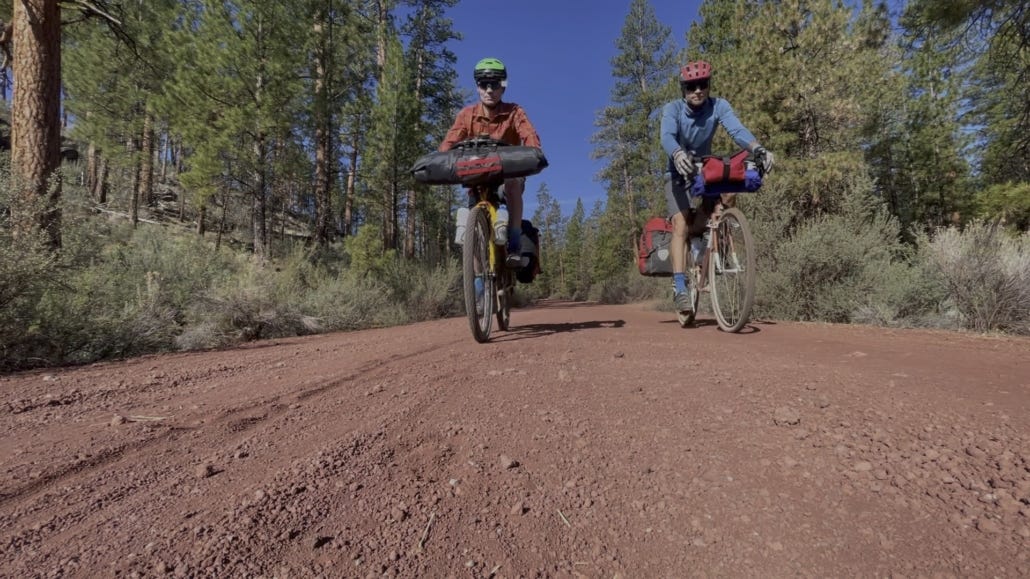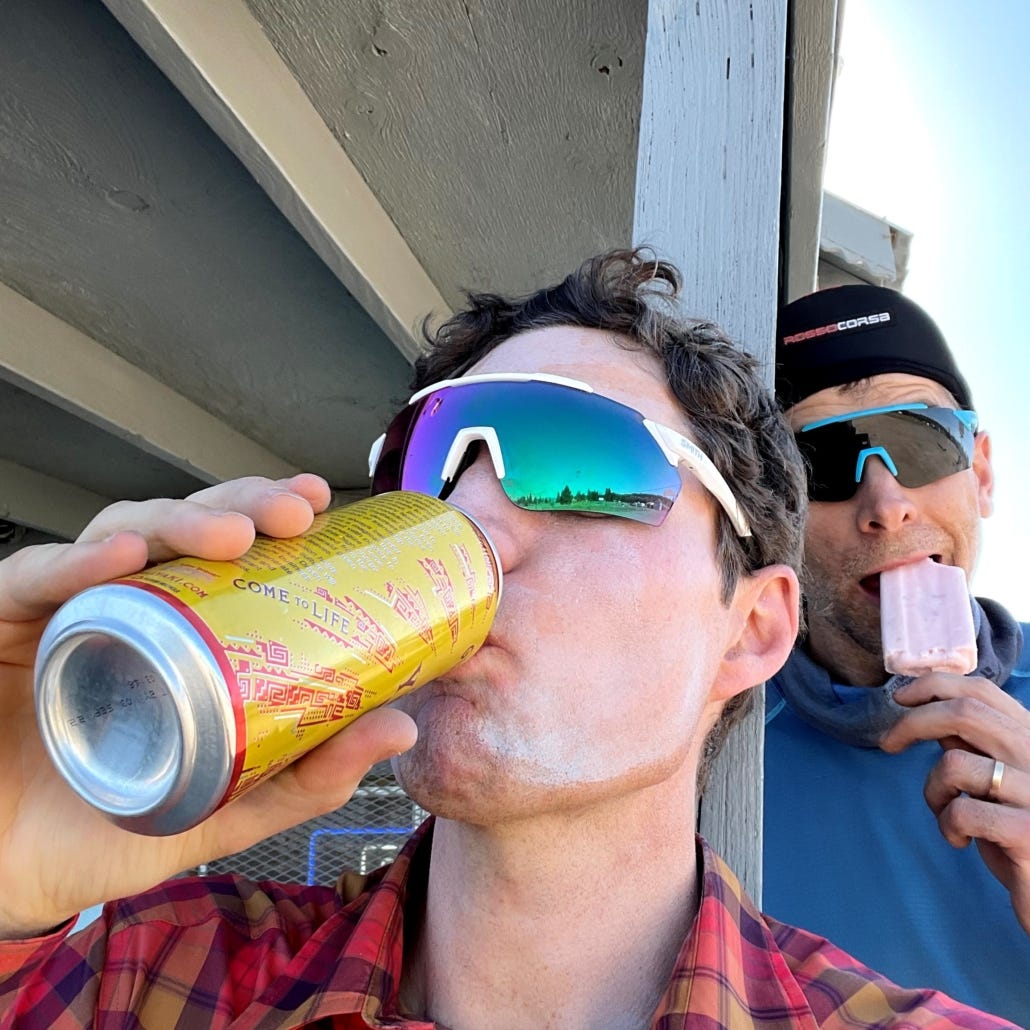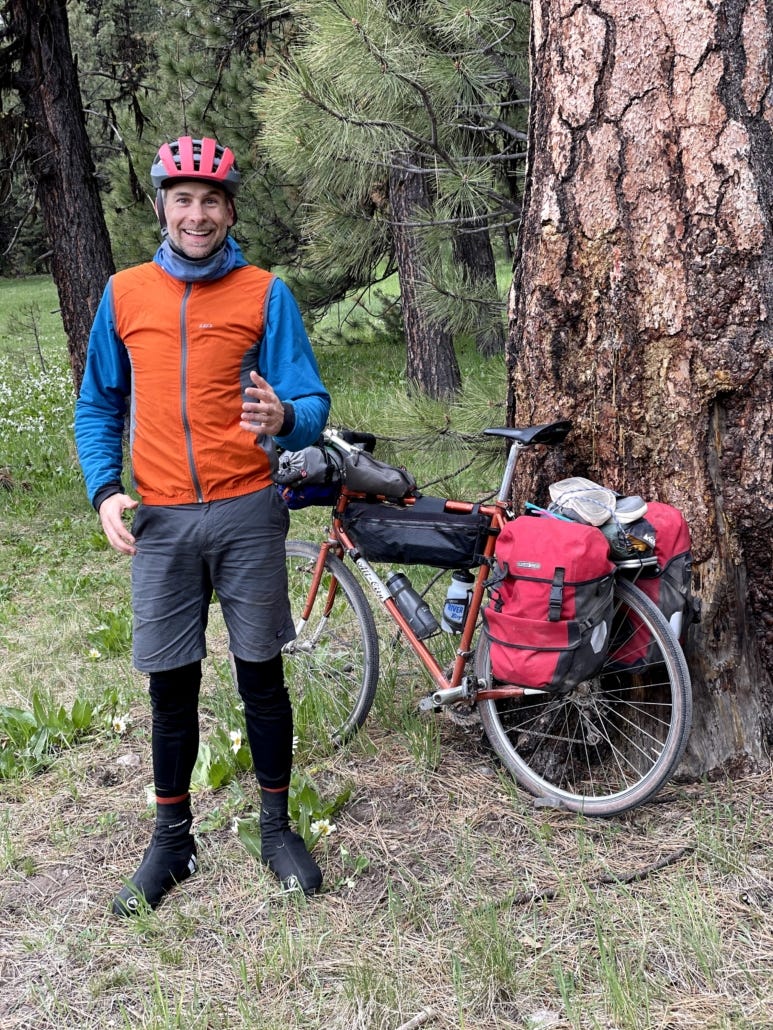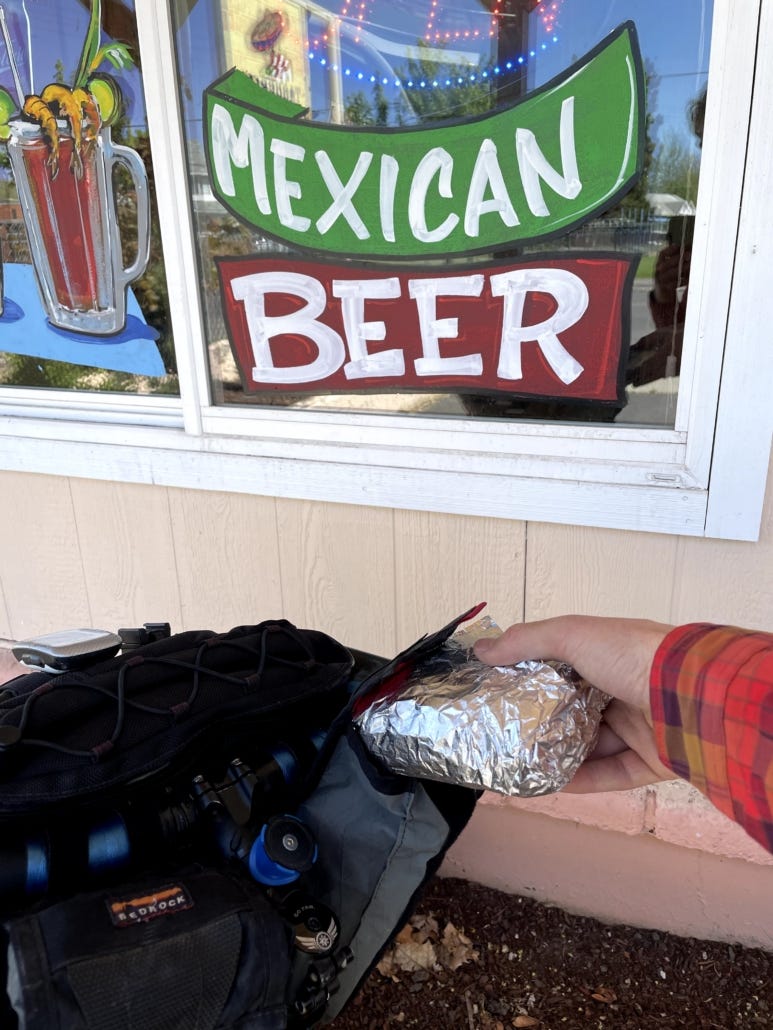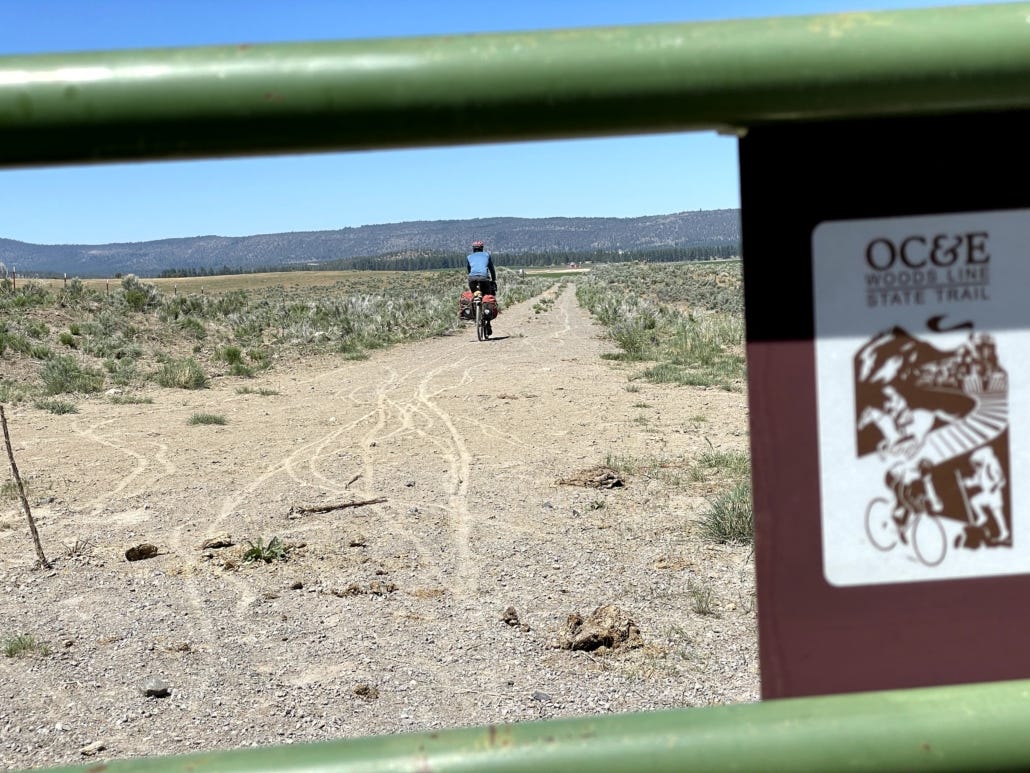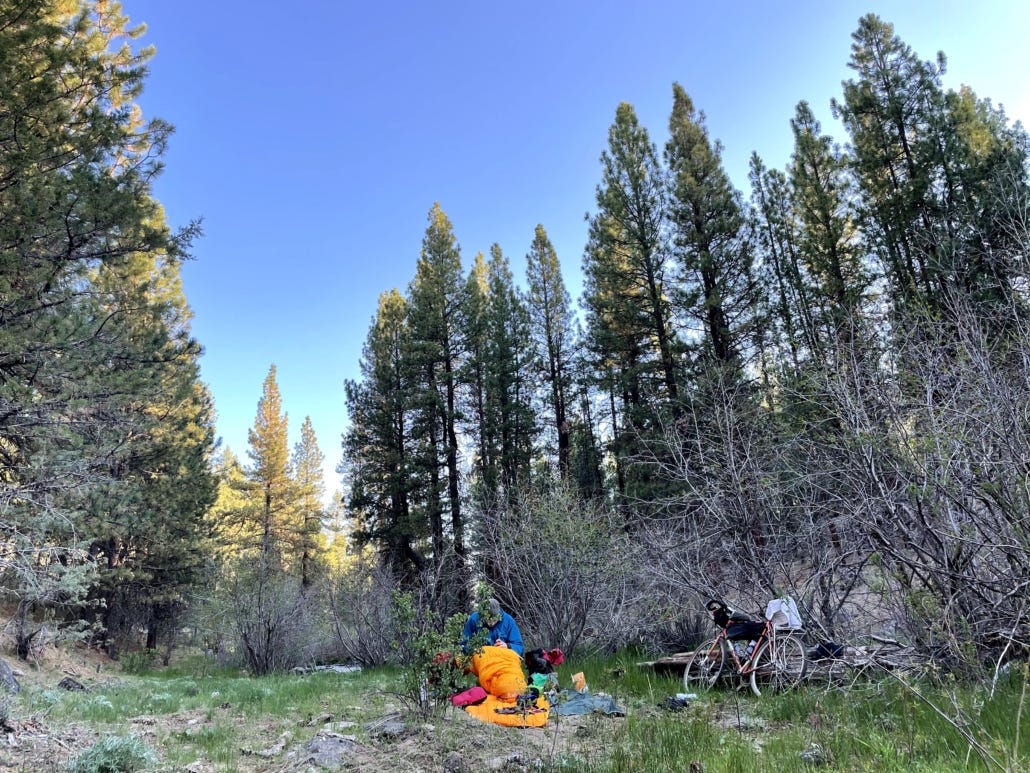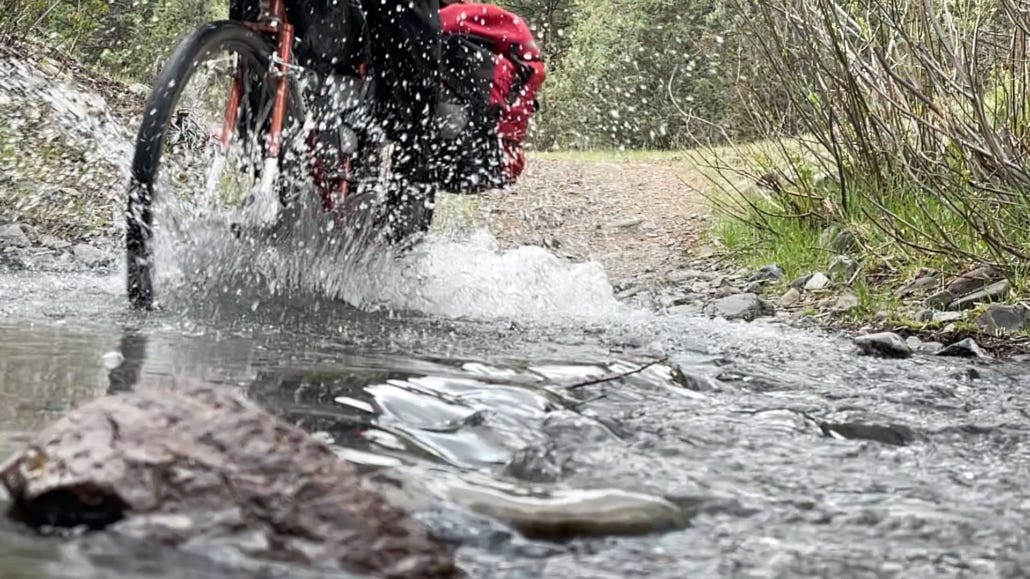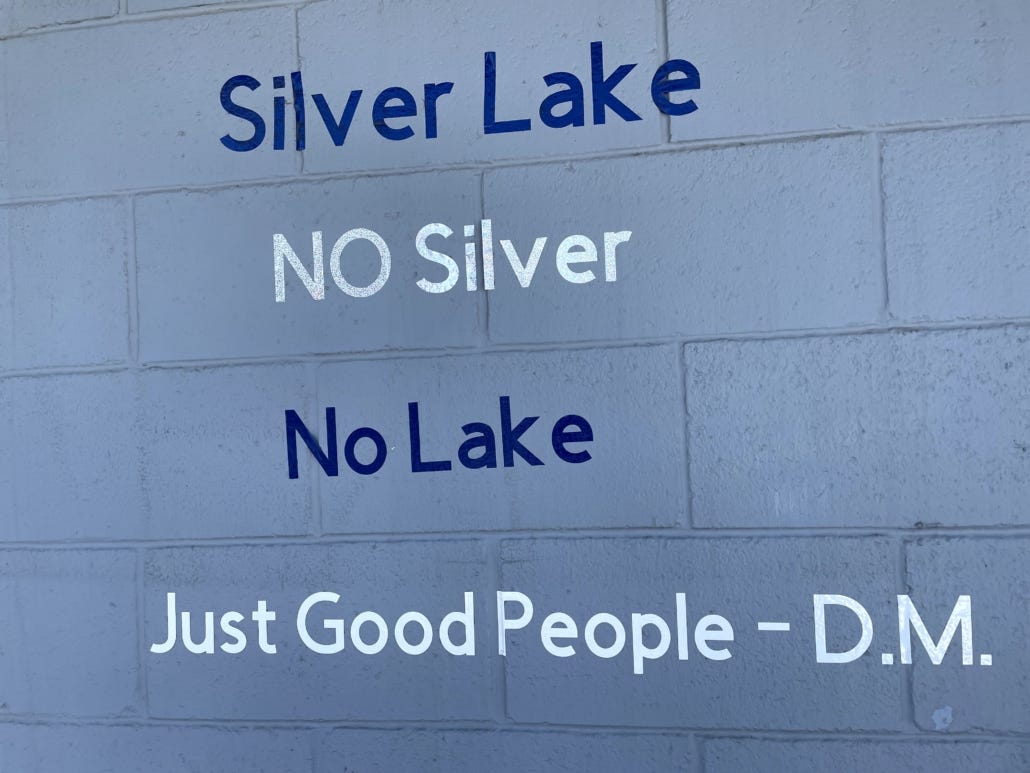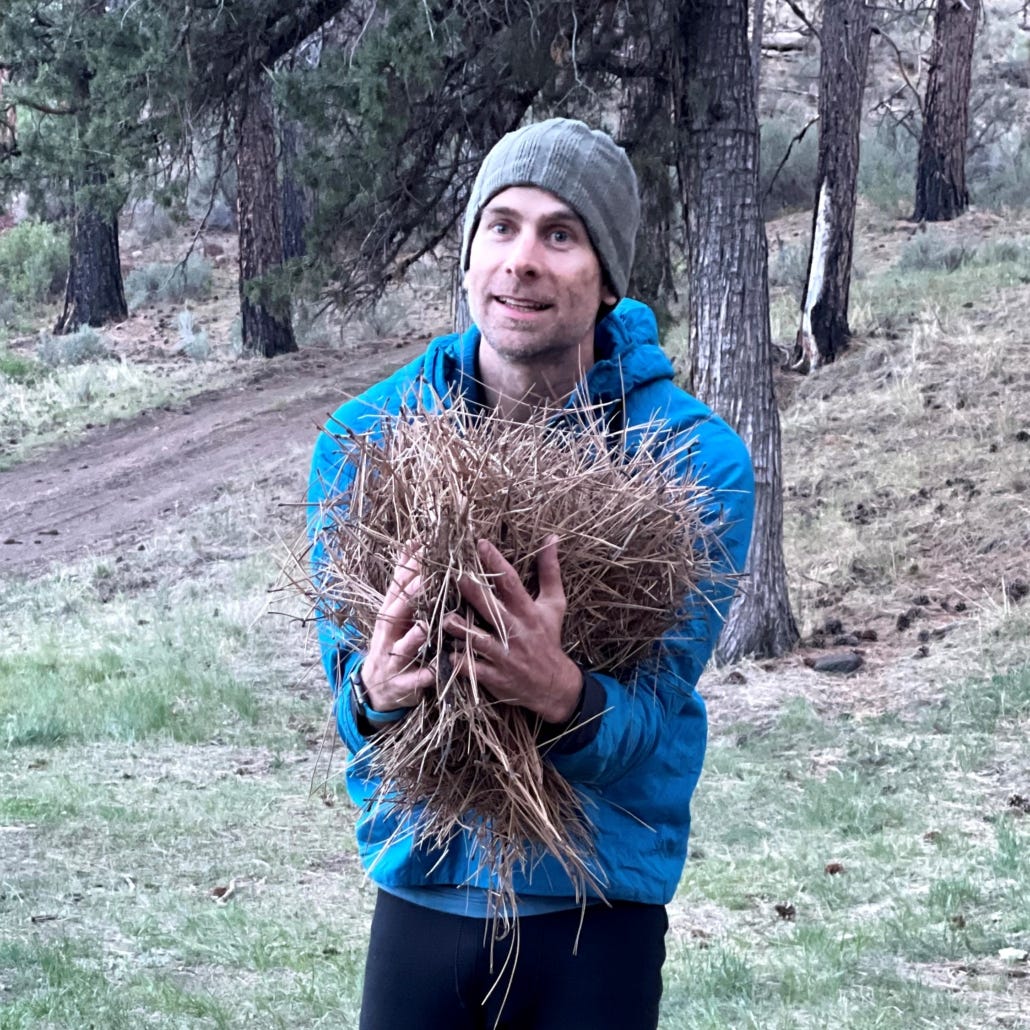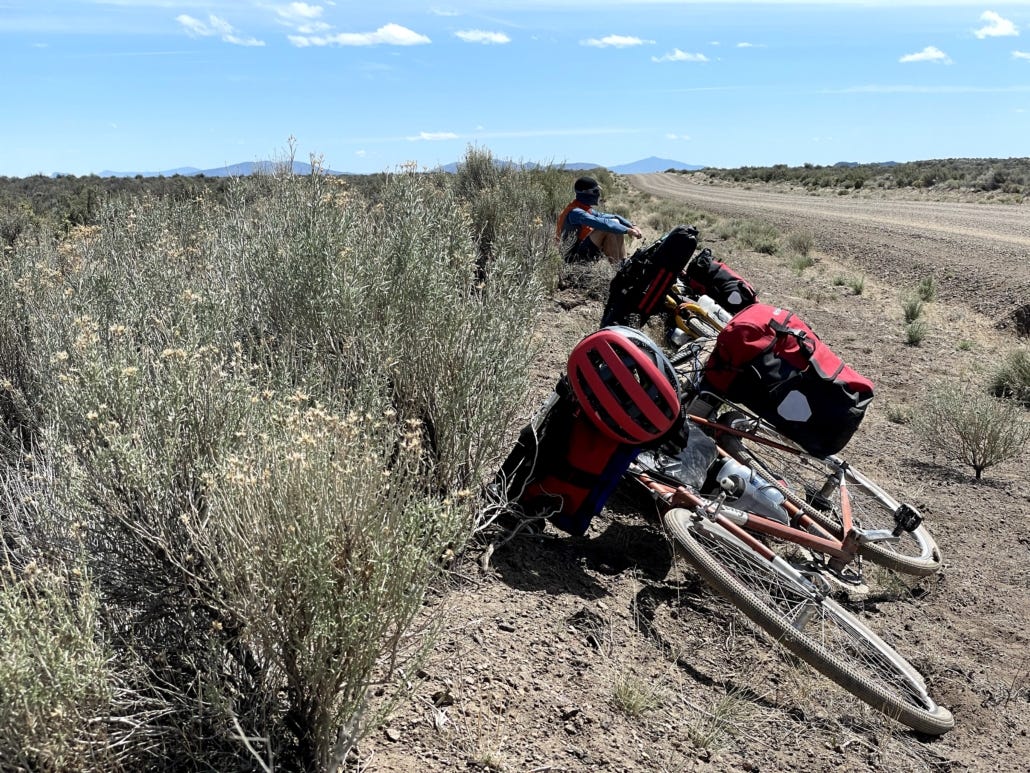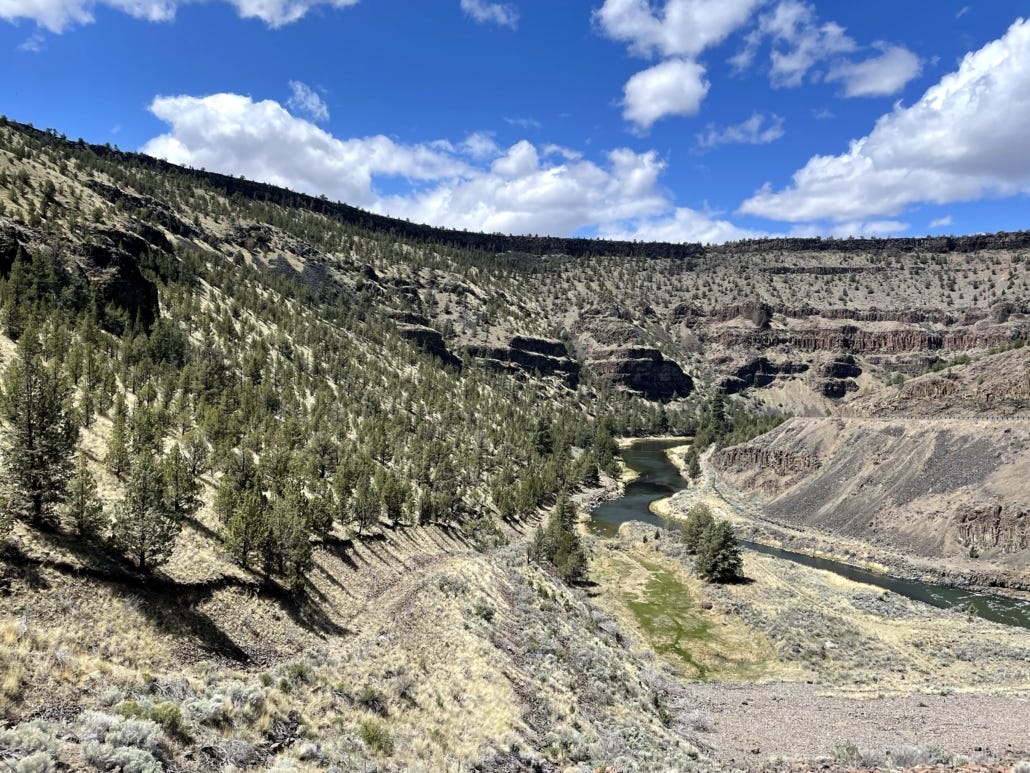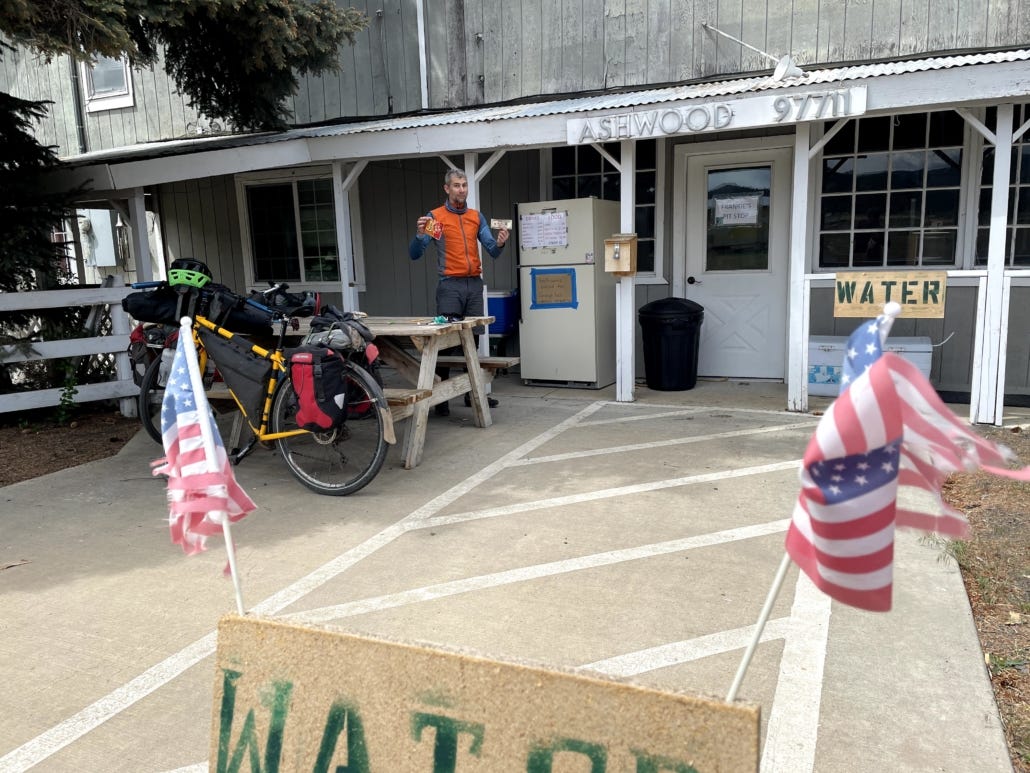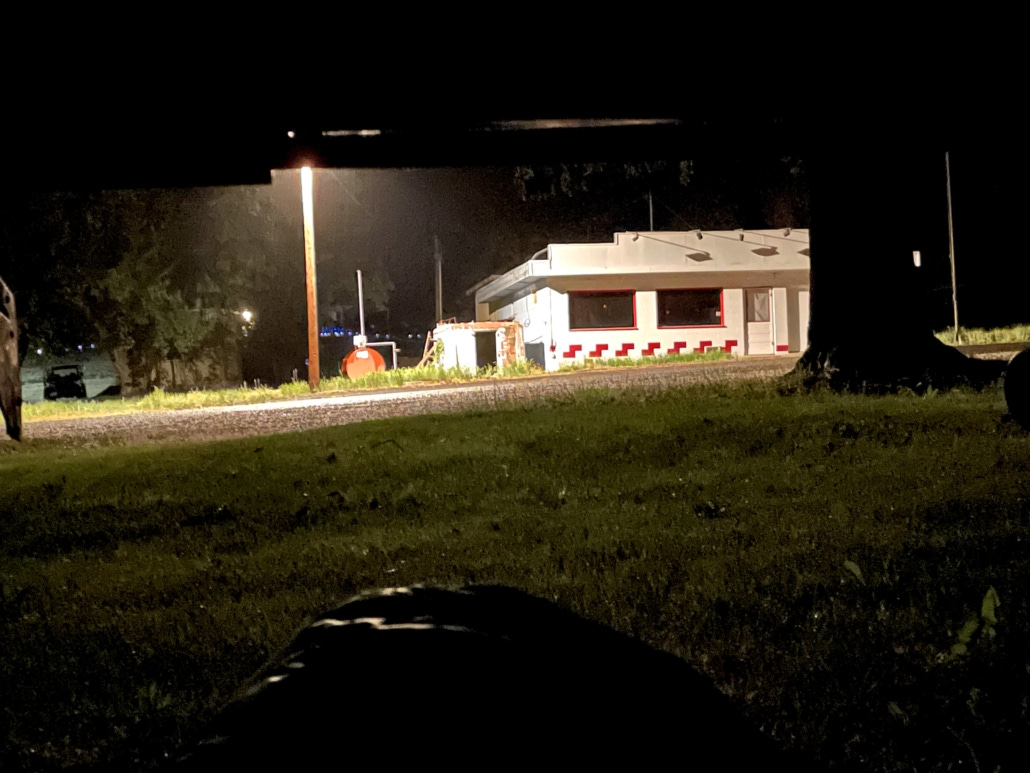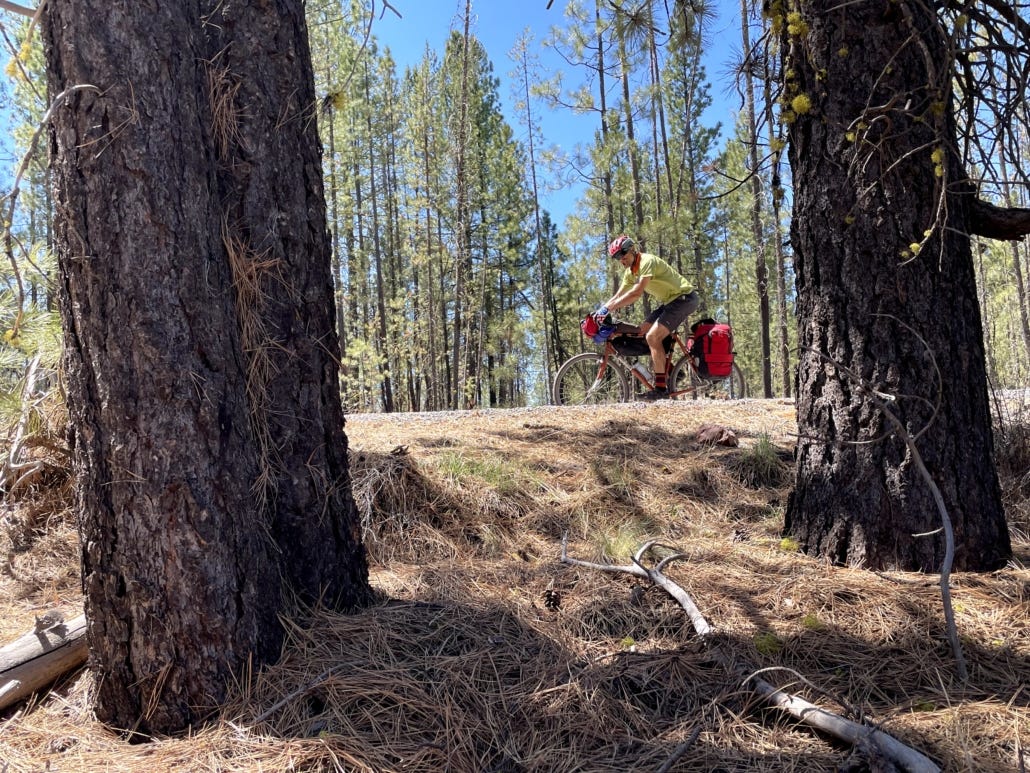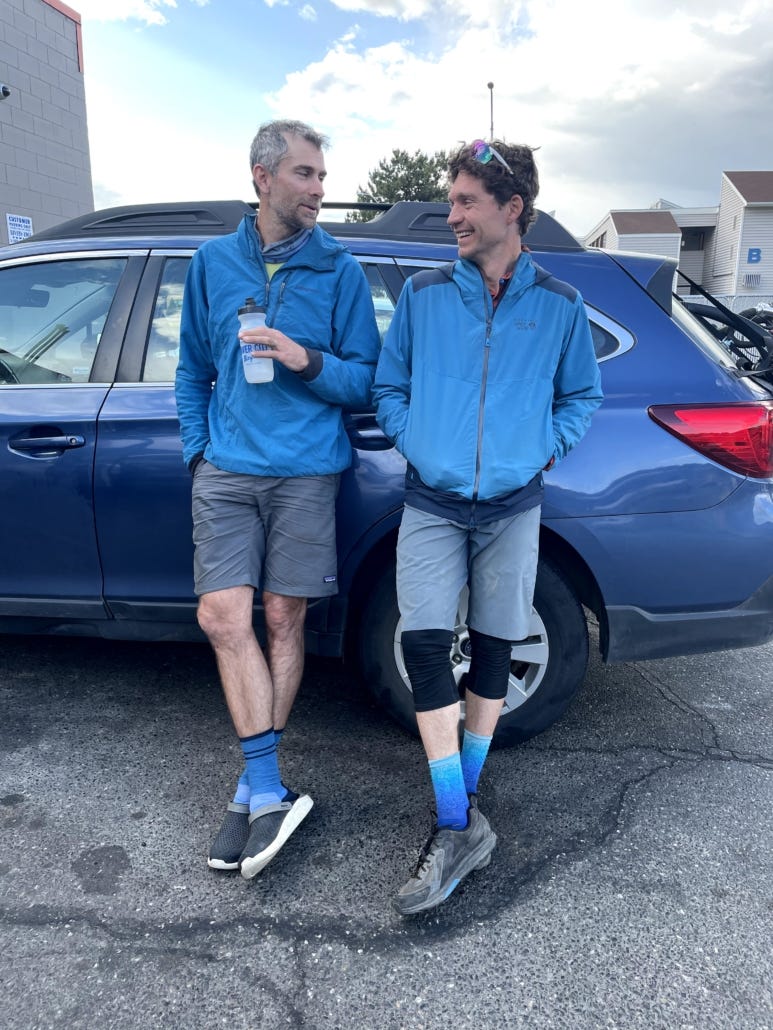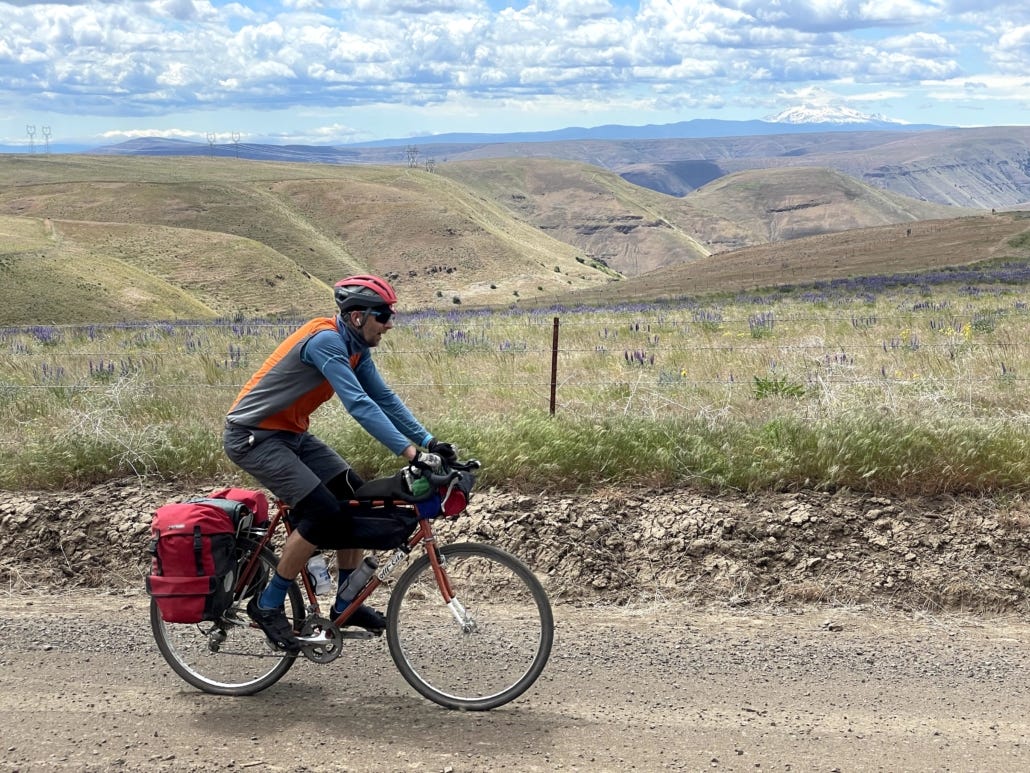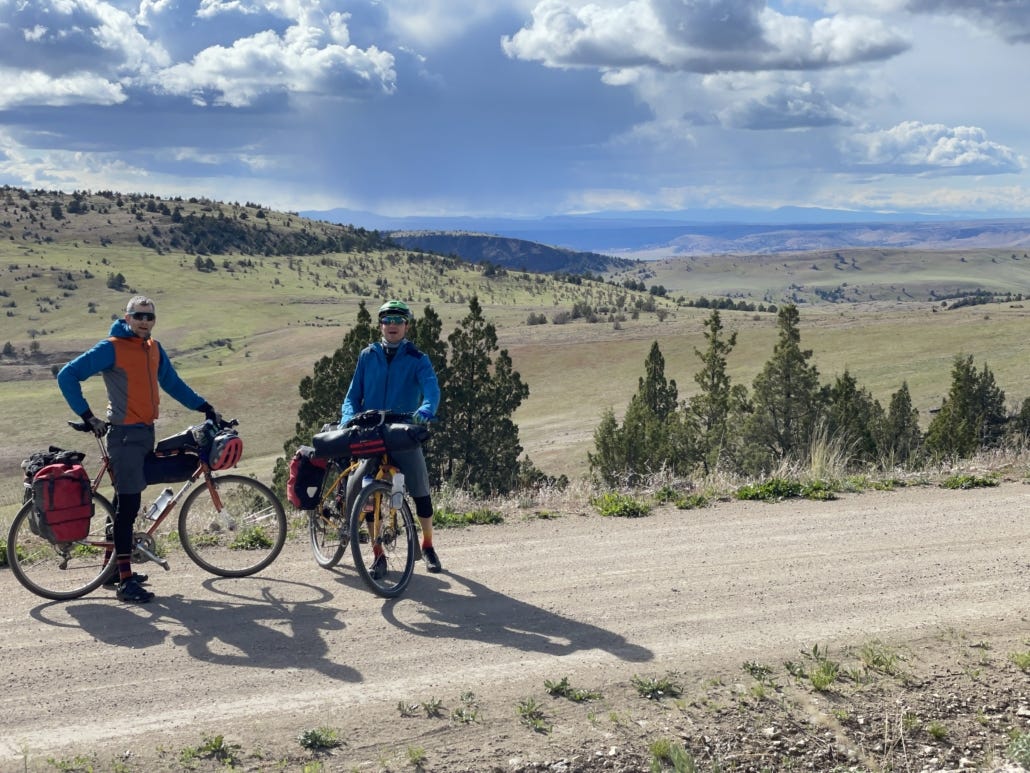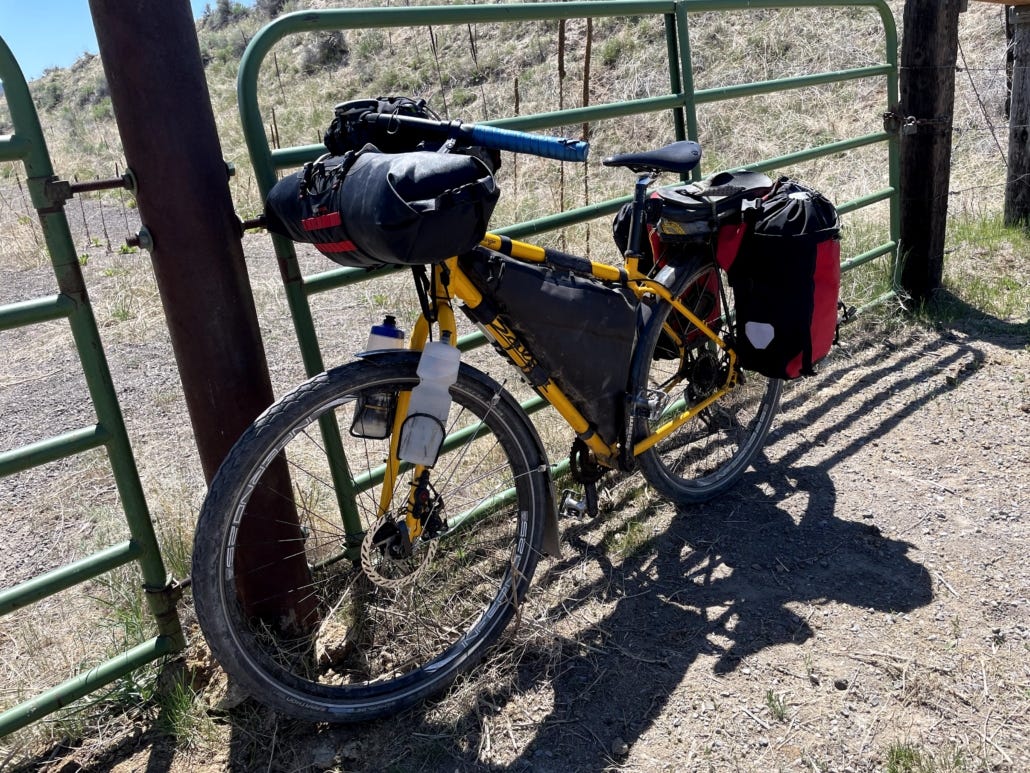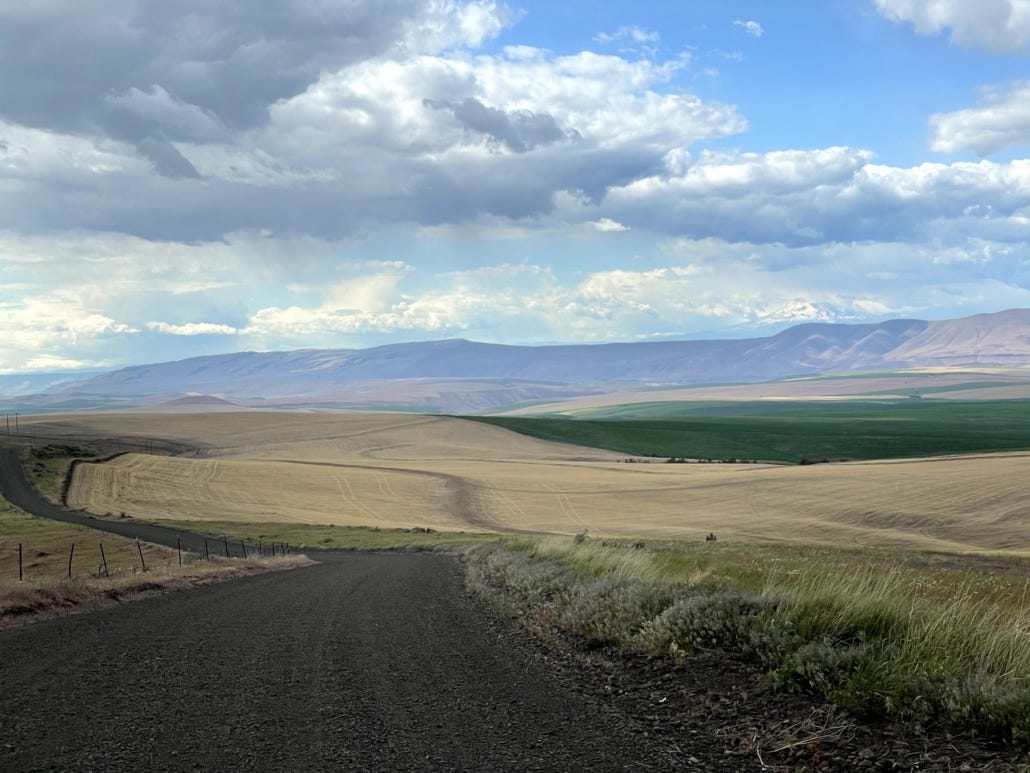Bikepacking Hijinks on the Oregon Outback
The buzzing on Jono’s bike started shortly after we rolled onto a tooth-rattling section of the OC&E rail trail. The culprit: his Crocs were dragging on the rear tire. “PHEW, glad I didn’t lose those,” he said.
“Hey, wait. Where’s my sleeping pad?”
Losing a sleeping pad a mere 13 miles into one’s first bikepacking trip might sound terrible. However, rarely do the Adventure Gods present such a prime opportunity for an entertaining story.
Me? I sat down to eat a taqueria burrito and watched my friend pedal toward the start in search of his wayward sleeping pad.
Day one of our bikepacking trip on the Oregon Outback was underway!
Blog Post Sections
Depending what you're looking for, you may want to jump around this article. Here are a few links to aid that:
Trip logistics: food, water, camping, navigation, etc
Don't feel like reading? Watch the five-minute video that Jono put together! If I say so myself, he did a fine job.
https://www.youtube.com/watch?v=uREIbpSJ3Ng
The Oregon Outback
The Oregon Outback is a bikepacking route that travels south to north across the state of Oregon. Starting in downtown Klamath Falls near the California border, it follows gravel, dirt and pavement for 360 miles to the Columbia River. Overall, the route is 75% unpaved and 25% asphalt.
The Outback visits lesser-known parts of Oregon and is famous for big desert views, lack of water, and occasionally punishing riding surface conditions. Speaking of the latter, the route features The Red Sauce, a nickname for the loose red soil covering a solid chunk of the first 150 miles.
The Sauce absorbs pedal strokes like a fat suit in a punching match and makes you sweat like you’re wearing one. At least the colors are fantastic – evergreens line the red road and views through the thin forest are beautiful.
The Outback takes a rider through a few tiny communities (e.g. Ashwood, population 55), plus a pit-stop in Prineville at mile 230. Mostly, you’re on your own for food, water, and bike repair.
Oh, and sleeping pads.
Onward on the Outback
My trip companion for the Outback, Jono, is the most enthusiastic, positive person I know. He speaks five languages, alpine climbs like a mountain goat, and is game for all manner of exploits.
For example, he bought a beater car in Spain and drove it for six weeks across eastern Europe and Russia to Mongolia. When it broke down in the Mongolian steppes, he traded the car for bus tickets to the Chinese border.
The Oregon Outback was his first multi-day bike trip and our first trip together, but I felt confident he’d overwhelm any newbie hijinks with his upbeat attitude. He’s slept in a climbing harness high up the wall on El Capitan, so he knows doing hard things is sometimes often the price of admission for outdoor hijinks.
Still, a man needs to sleep, so I grinned in relief when he pedaled back into sight carrying his wayward sleeping pad. Turns out Jono’s pad squirted off his bike a mere ¼ mile from where we noticed it’s departure. Unfortunately, a cyclist headed the other way picked it up and only Jono’s Herculean efforts to catch him reeled in the wayward pad.
Back on the road. Nice to get all the bad luck out of the way early, right? Riiiight.
Want the real details? Read on.
By the way, dig these kinds of posts? Sign up for the free 2x/month Traipsing About newsletter for more tales from the bike plus creative adventures like drawing and piano when I'm off the bike.
My Experience Riding the Oregon Outback
Day 1: heat, cows and bike paths, Klamath Falls to middle of nowhere
Sleeping pad reunion complete, but parched from the heat after four hours of riding the gravel OC&E rail trail, we pedal into the gas station in tiny Sprague. The employee asks zero questions and clearly couldn't care less what we are up to. A reminder that most things we personally find intriguing are boring – or insane - to other people.
I soak my head and shirt with the gas station’s garden hose, a sublime moment. Bike trips (and maybe life?) are all about the small moments of joy, the stark contrasts of hunger and food, heat and cold water.
A punishing traverse of cow pasture hell pushes us out off the rail trail and onto smooth pavement. There’s no glory in arbitrary suffering, people: if it’s not a race or an FKT attempt and you have a better option, take it!
A tooth-rattling final section on The Red Sauce - mitigated by The Queen’s Gambit audiobook - gets us to the campsite, 68 miles in. Sure, there’s an argument for staying present, but I don’t need to pedal every second of an 8-hour day with angry thoughts pinging around in my head.
A quick rinse in the creek, dinner, cowboy camping under the stars. Day 1, check.
Day 2: middle of nowhere to Silver Creek
We warm up by batting large rocks around with our tires on the initial climb. Bike Tennis! We talk about bear attacks as we pedal, a relaxing topic for a camping trip.
The OC&E rail trail ends and I tearfully bid The Red Sauce goodbye (for now). Pavement is delightful sometimes, especially when there's only a car every hour. We cruise through the Fremont National Forest as the midday heat builds.
When energy levels lag, we take a quick mid-afternoon break...which turns into an hour sitting in the shade and chatting about business ideas. As I tell Jono, we can sit here or we can sit in camp later - what’s the difference? We aren’t racing, let’s enjoy it
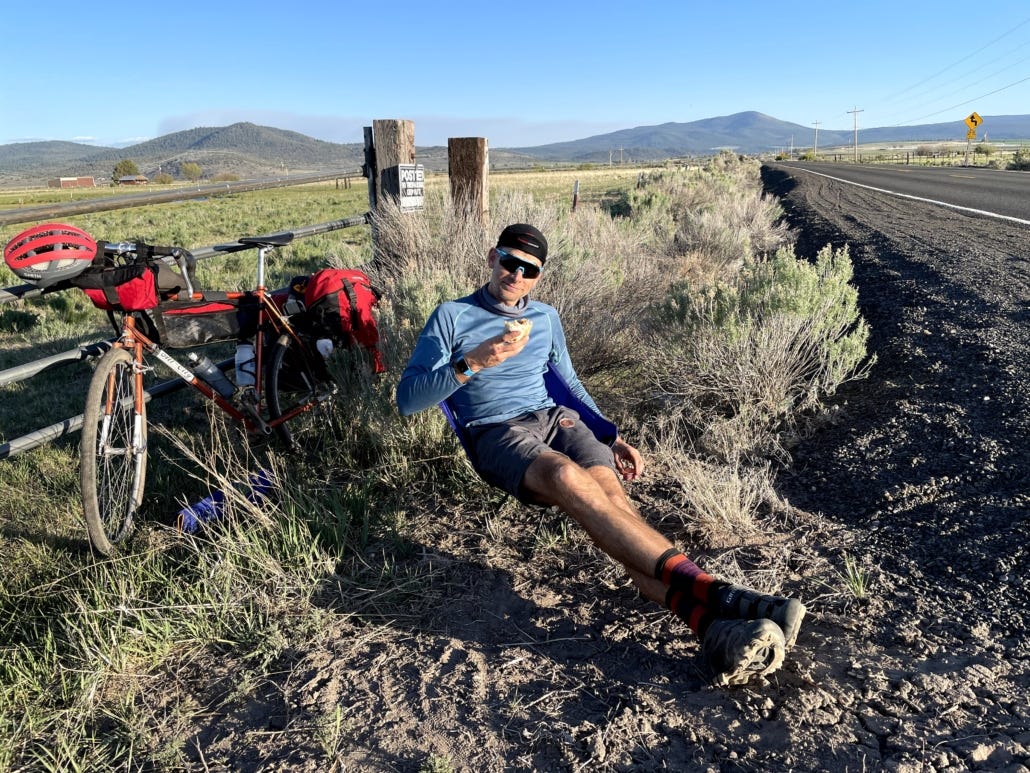
Like every day on the Oregon Outback, we are tired by the end of the ride. Algae-filled shallow Silver Creek isn’t particularly enticing, but beats sleeping coated in dust and sweat from a day of pedaling.
Freeze-dried pad thai + soy curls all stuffed in a burrito = dinner. Bikepacker hunger is already setting in! Eight hours of biking will do that to a person.
My biggest takeaway of the day is Jono’s wise advice for outdoor trips: always eat your best food, because then you’re always eating your best food. Simple and brilliant. To hell with delayed gratification! Don’t save the cookie or your best freeze-dried meal for the end of the trip. Eat your best food, now.
Day 3: Silver Creek to OHV Sand Springs
If I squint extra hard, bike trips are a compressed version of life. Uphill battles, too-short moments coasting downhill, shattered expectations (e.g crushing headwinds on a flat day of pedaling)…and unexpected surprises.
SURPRISE: Jono breaks his rear shifter 20 miles in on day 3, leaving him unable to change gears. Somehow, he remains imperturbably positive and rolls with it. My positive contribution is a nickname, Single-Speed Jono. I’m such a helpful trip companion.
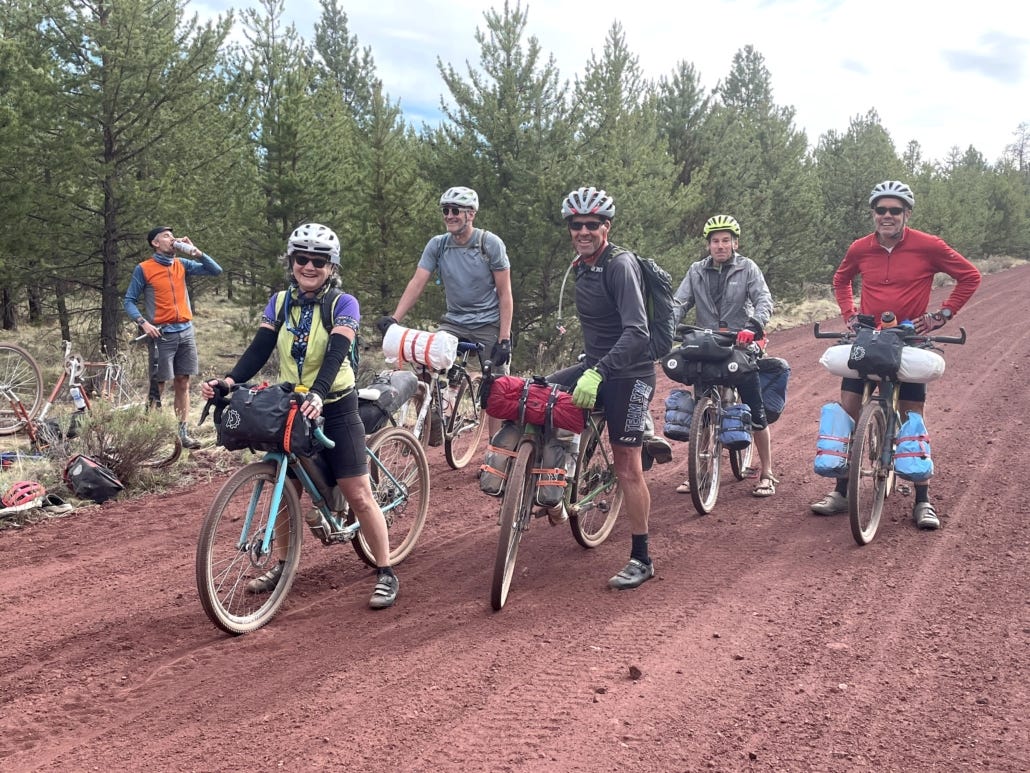
On the bright side, a road grader tamed the washboard gravel out of Silver Lake. You better believe we waved at the driver!
A good moment to point something out: when you’re traveling on a bike, be an ambassador. Stop and talk with people. Wave at ranchers and farmers when they slow down to pass. Be courteous and curious. Ask questions about towns, how many other cyclists they see. Pave a smooth path for the next exhausted, dehydrated cyclist.
Case in point: the Silver Lake convenience store has PopTarts (yesss), but no tap water. After some amiable chatting with the proprietor, he lets us refill at his house next door. The same thing happens at the Ft. Rock greasy spoon. However, the waitress tells me cyclists keep using the outside water without asking or buying anything, so they’re closing off those hoses. Be an ambassador, people!
We pedal on. It’s hot. Windy. Deep red gravel sucks energy from our tired legs. DAMN YOU, RED SAUCE. Spirits crash. These things happen while pedaling 6-8 hours a day and spending all day outside in the elements.
Oh, right, I’m hungry. When my attitude shifts into negative gear, it’s (almost) always food. A few olives and a PopTart revives my spirits.
Our campsite that night is the aptly-named Sand Springs. No water, but we carried enough from Ft. Rock to handle the 100+ water-free miles. Plus, it’s COLD, so who needs water anyway?
Jono warms up by gathering pine needles to pile under his leaky air mattress, which is clearly punishing him for losing it earlier in the trip. He’s a survivor! We both zonk out by 9 p.m.
Day 4: A snowy, windy day from Sand Springs to Prineville
It’s late May, yet we wake up to snow flurries at Sand Springs. It’s cooold. We don all our layers and roll out early with Prineville’s bike shop as the destination. (Single-Speed Jono needs more gears!) How he’s pedaled these rolling hills in sucking gravel without popping a knee or an emotional gasket is beyond me.
Snow may sound miserable, but I’d rather ride in the cold any day vs. scorching heat. Plus, Jono spots some sunscreen on road, which means we are ready for temps over freezing.
A cool highlight: running into Lael Wilcox, a badass Alaskan woman who has won the Trans-American bike race and is well-known in the ultra-endurance cycling community. She’s scoping out the Outback in preparation for a time trial on it.
Her advice for the road ahead is that there’s water in a cow trough 20 miles up. When we pass it, in NO way do I feel like filtering water from it. Besides iron backsides and the ability to pedal forever on zero sleep, ultra-endurance riders like Lael also possess the ability to rough it to an extreme degree. I enjoy some adversity, but draw the line at cow trough water.
This day reminds me why I prefer bikepacking on trails to open roads: headwind hell. We push north toward Prineville reservoir through snow flakes and/or furious wind, earning a reprieve with the long, fantastic descent to the reservoir. A nice lunch by the river is followed by brain-scorching wind in the face all the way to Prineville. I put my head down and descend into audiobook land.
Good Bike Co. can’t fix Jono’s shifter. Instead, the mechanic clamps the shifter cable to the chainstay. The shifter is useless, but by twisting the barrel adjuster, Jono can access three gears. We are good to go!
Bike trip hunger sets in. We eat burritos, but they don’t even register as calories. “You still hungry?” Yup. We order two more and head to the Best Western. It’s our lone night sleeping inside on the trip and we take advantage of it, washing out soiled clothing and hitting the hay early.
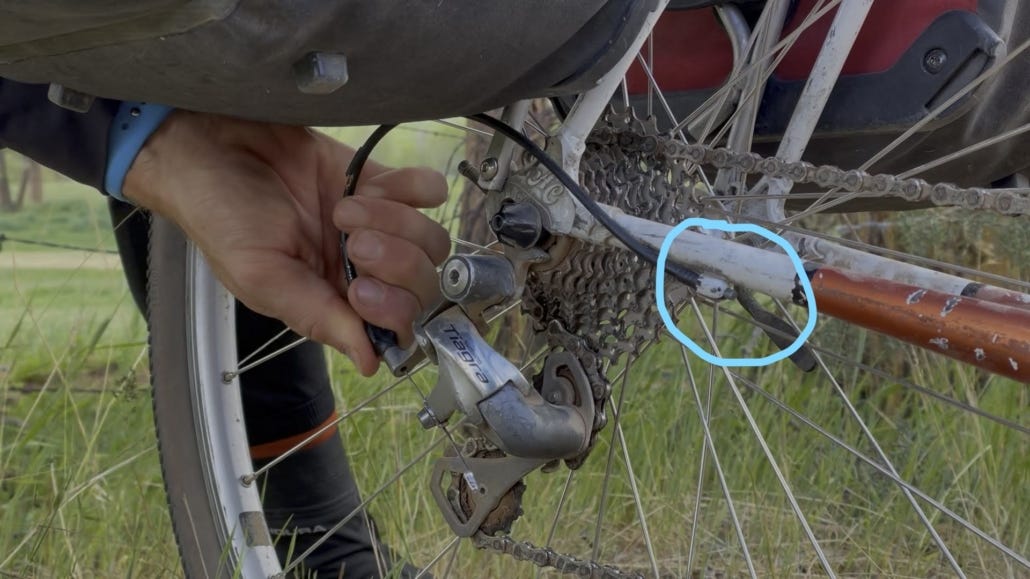
Day 5: Big climbs and sweet views from Prineville to Antelope
Into the Ochocos! Jono is dragging (for the first time ever?) as we crest the first climb out of town as temps dip toward 30. A snowstorm blows through behind us, but our bike karma is good and we dodge it.
The splendid long descent north of Prineville is steep enough for grinning and freezing enough to warrant using the handwarmers and all the layers we have. We blast through creek crossings and enjoy the area’s remoteness.
In tiny Ashwood, an oasis appears: Frankie’s Pit Stop. Frankie’s is an honor-based fridge with snacks provided by a generous guy. Ahh, the magic of small kindnesses during bike traveling. Far more impactful than typical travel because you’re so exposed on a bike and a $1.00 bag of Fritos can transform a day. Or power the steep climb out of town.
We burn all the calories from Frankie’s in the next few hours, traversing a rolling ridge with great views. No cars, just wind, distant mountains, and a great afternoon of riding. Weather threatens, retreats. Life is good.
Our day’s destination is tiny Antelope, a town documented in Wild Wild Country about the Rajneeshees. We don’t wear red, but I’ve arranged a free lawn to sleep on. When it starts to pour that night, our cowboy camp shifts to underneath the RV stored on the lawn. Dreamy.
Day 6: a rainy, windy push to the finish
Rain, ugh. I curl up in my sleeping bag under the RV, avoiding the inevitable. Jono woke up hours ago, as usual, journaling away in the dim morning light.
Luckily, the rain lets up as we climb out of Antelope. A big truck pulling a boat stops in the middle of the road and a grinning guy in a WSU Cougars hat sticks his head out into the drizzle: “You all are awesome!”
The tiny town of Shaniko is quiet and abandoned. Wherrrre is the water we expected? We bail - 2 bottles on a cold day is enough for 70 miles, right? (Spoiler alert: no, it’s not.) We stuff food in our faces and pull onto highway 97, heading north.
Ah, highway touring. We lurch along with semis buffeting us toward the ditch. Just 13 miles… A reminder: avoid road touring, Dakota! We turn onto gravel with a sigh of relief. The end is in sight.
We plop down by a farmer’s field for an excellent lunch of Tasty Bite chana masala. A guy in a farm truck stops and says we can stay, but don’t leave trash anywhere. Do people do that?! Be an ambassador, folks.
The Final Push
Onward. We grunt up steep gravel rolling hills reminiscent of my hometown in the Palouse. A big rattlesnake in the road sends my heart skittering, but he merely watches me huff by.
We’ve pedaled 345 miles and the end is in our sights. From ebullient energy out of Klamath Falls to lost sleeping pads to sunset burritos by the side of the road to cow pastures, through Red Sauce and broken shifters and snow, it feels like a hell of a trip. And yet we’ve only spent six days out here. Time compression, an indicator of a fine excursion!
But we aren’t there yet. A final cliff-steep hill, straining at the limit into a headwind on bumpy gravel to a crest overlooking the Gorge, Mt Hood and Mt. Adams. We’ve got 15 miles of descending as our reward...straight into a furious headwind that owns us, wind turbines merrily celebrating our imminent demise.
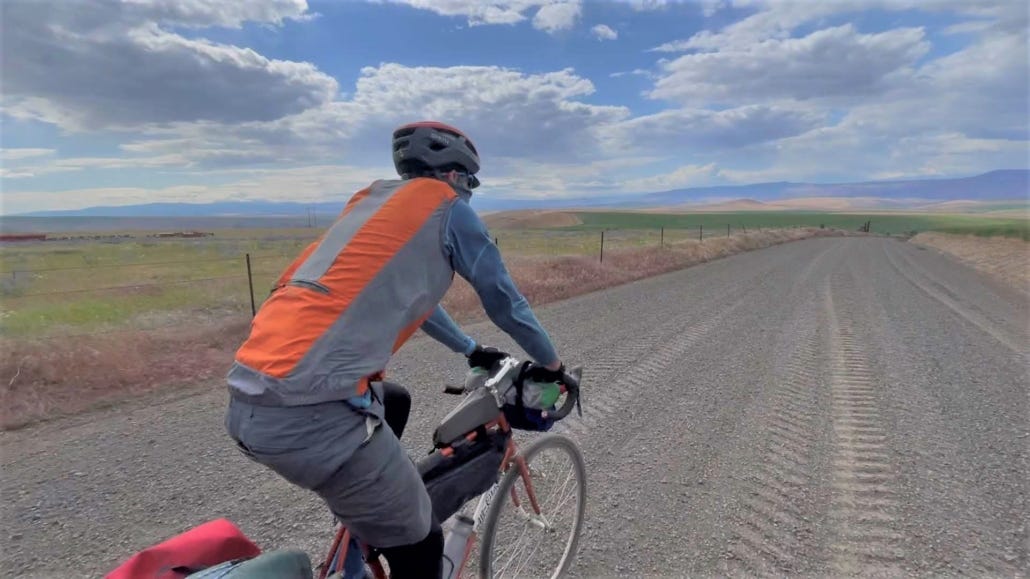
We grind. Grind grind grind. I stop pedaling – on a steep downhill – and the wind blows me practically to a stop. Not much talking. Survival mode. A fitting conclusion to a bike trip, in many ways. I tell Jono the good news: he’s now seen headwinds as bad as any I’ve seen in 10,000 miles of touring.
And then we’re done, Jono’s mom waving as we pedal up. She hands us cold water and I chug a liter, then another. Yup - two bottles for a 70 mile day is not enough. Chelsea meets us in The Dalles with piles of fruit and kombucha and I down blueberries by the handful.
Parting Thoughts on The Outback
Another one in the books. Headwinds aside, the Oregon Outback is a fabulous route!
Compared to road touring, the Outback is more remote and presents more logistics with water and food. However, those added items and ocassionally bumpy roads are more than offset by essentially traffic-free riding the entire time. I think it's a great bikepacking trip for someone looking to dive into multi-day gravel riding.
I found the Outback to be more physically draining than expected. We rode 6-8 hours every day and no day felt easy. The vertical gain is fairly low, but the headwinds, bumpy terrain, and Red Sauce proved challenging. Don't take it lightly: there's hard work in them hills! (FWIW, I've toured 10,000 miles on road and trails.)
Beyond that, Jono proved himself a marvelous trip companion, positive and cheery no matter what the Bikepacking Gods threw at him. We’re better friends thanks to conversations about bear attacks and business, love and travel, language learning and the future. By that measure alone, the trip is a success.
It felt good to tick the Outback off my bucket list. I wasn't left wishing I could pedal more; I was excited to return home to playing piano and other creative projects. The Oregon Outback filled my adventure cup - with an extra pour for Jono - and served up a solid helping of laughs, beautiful views, hard work, self-sufficiency, and teamwork.
I also suspect Jono will enjoy returning to a bed that doesn’t fall off his bike, leak, or crackle like pine needles.
The. End.
Tips and Suggestions for Riding the Oregon Outback
For reference, here's my full Ride with GPS recording from the trip. It follows the official route from Bikepacking.com.
Day 1: Klamath Falls to creek camping on the OC&E Woods Line Trail. (68 miles.)
Mostly cruisy except for occasionally bumpy terrain. Overall, running lower tire pressure will save your wrists, butt and soul a lot of pain. We didn't go low enough day 1! 30-40 psi on my 29er/2" tire setup felt good.
If you continue another ½ mile past the gate where the creek appears (roughly mile 68.5 from downtown Klamath Falls), there’s a fantastic camping spot on the west side of the trail with a swimming hole.
NOTE (please heed): unless you enjoy beating your body and bike to death, skip the OC&E trail from Sprague to Beatty. We disregarded a previous rider’s instructions and the result was brutally rocky cow pasture hell. After a few miles, we cut through a field and hopped on siiilky smooth pavement to Beatty. One of the better decisions of our trip!
Day 2: OC&E to Silver Creek (52 miles)
It’s an easy roll on pavement down into the town of Silver Lake, but we wanted to camp in solitude versus a city park, so we opted to stop earlier and enjoy the evening at Silver Creek. There is good camping near the creek.
NOTE: We read there wasn’t any water all day, but plenty of swamps and creeks presented themselves in the first half of the day. We didn’t need any of it, but maybe not necessary to carry a full day’s water out of the gate.
Day 3: Silver Creek to Sand Springs OHV (56 rather hard miles)
A surprisingly tough day, mostly due to road surfaces and a burly headwind. Since camping is limited past Sand Springs, we opted to dry camp there. Leaving Ft. Rock with six liters gave us plenty of water for the day, dinner, and pedaling to Prineville Reservoir the next day to refill.
Save some energy for the soul-sucking Red Sauce and punchy hills north of Ft. Rock!
Day 4: Sand Springs to Prineville (62 miles)
A cruisy, trending-downhill day. Other than waking up in snow and a cold morning of pedaling, all good!
Day 5: Prineville to Antelope (70 miles...and I should mention the 5,500’ climbing)
My favorite day of the trip for the views, remoteness, and variety of terrain. The four creek crossings were no big deal – we rode three and forded one. The descent after the climb out of Prineville is long and the perfect grade. If you’re continuing past Ashwood (and the fantastic honor-system Frankie’s Pit Stop), prepare yourself for a steep climb out of town and about 2.5k more total vert to Antelope.
For camping in Antelope, there’s a 5th wheel trailer on the east side of the road as you pedal into town. Nailed to the tree is a laminated note with Rodney Shank’s phone number. Give him a ring/text and let him know you’re staying and you’ve got a spot for the night!
Day 6: Antelope to the finish (70 miles and another 4,000' of climbing)
A nice warm up out of Antelope, then highway traffic on 97 (blergh) before hitting the gravel again for rolling hills. May the wind be at your back and not blasting you to death the way we experienced. Stunning views of Mt. Hood and Mt. Adams abound as you descend into the Columbia Gorge.
Note: this day would be RAD if it rolled through Maupin and down the Deschutes River Rail trail to the finish. However, there’s currently a couple miles of chunky rock scrambling that would suck on a loaded gravel bike. Hopefully the trail is eventually clear from the Columbia to Maupin!
Logistics for the Oregon Outback
Getting to/from start/finish
We caught a ride with a southbound friend from Bend to Klamath Falls. There’s a train from Portland to Klamath Falls, which seems like a great option.
From The Dalles, there’s a bus (the Columbia Area Transit, CAT) back to Portland. My lovely wife, ever supportive, picked me up at the end.
Time of year
We rode this from May 16-21, 2021. Temps ranged from 85 one day to freezing and snowy another, but I'll take cold ANY day versus baking heat in the desert. My vote is for riding in the late spring.
Navigation
Navigation felt easy on the Oregon Outback. I simply downloaded the suggested route from bikepacking.com and used Ride with GPS to navigate. The app is easy to use and only costs $6 per month.
My preferred method to save battery is to keep my phone on airplane mode with the volume turned up loud enough to hear the DING when a turn is approaching. There's also another tone when you miss a turn, which quickly corrects any missteps.
Food
As usual, I rolled on a plant-based diet for this trip. Jono joined in and went veg as well.
We brought enough freeze-dried meals to get us through the entire trip, but left Klamath Falls with a few big burritos for dinner the first night. Two big dinners in Prineville got us fueled up quite nicely as well and convenience store stops in Sprague and Silver Lake kept us in PopTarts and other unhealthy-yet-delicious snacks.
Riding on a vegan diet and curious what you can find in convenience stores? Traipsing About reader, badass cyclist and fitness coach Lauren Costantini put together a list of foods for all you plant-based folks.
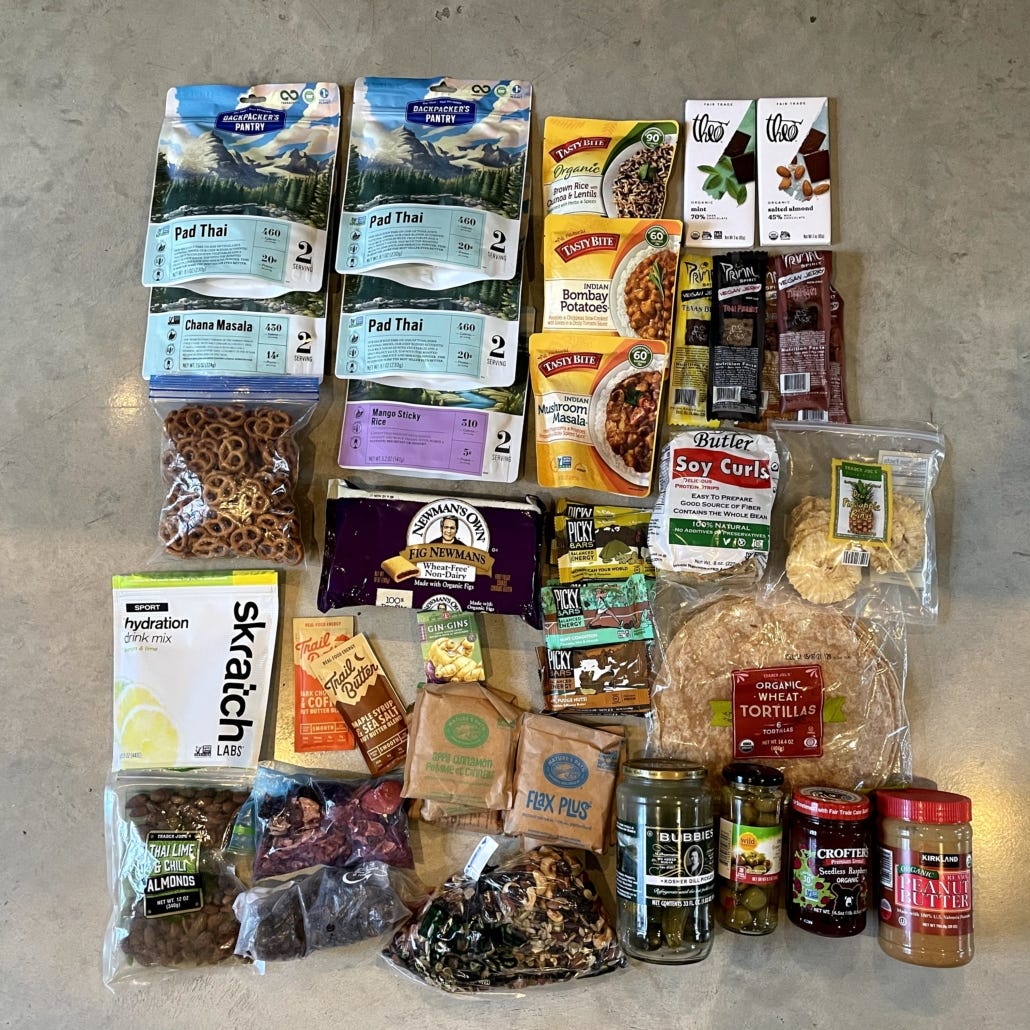
Water
Nooot much water on the Oregon Outback, but there was plenty for us. Except when there wasn’t. All of the water sources we filtered from seemed strong and not at risk of running dry in the summer or fall, but I have no idea if that's the case.
Follow the advice of the writeup on bikepacking.com and you’ll (likely) be fine. Worst case, just haul 6L of water - the terrain is mostly flat and there is zero hike a bike or downed trees to navigate, so who cares about an extra few pounds?
We both used the Katadyn BeFree filters and they worked great. Skratch Labs electrolyte powder in one bottle and pure water in the other is the ticket.
Sleeping
We brought a Big Agnes Fly Creek UL2 bikepacking tent and split carrying duties between poles and fabric. However, we never used it and just cowboy camped for free every night except the one we spent in a hotel in Prineville. There’s lots of public land for doing so, plus spots in places like Ashwood and Antelope. (See previous note about Antelope camping.) Zero mosquitoes, woot! A silver lining to no lakes for swimming
Cell signal
With the exception of north of Prineville, there was a Verizon signal almost the entire ride.
Gear
I rode my 2013 Salsa Fargo set up very similarly to how I rode it in Spain/Portugal with Jones bars and panniers plus a Salsa frame bag. This time around, I added a Revelate front roll bag for sleeping gear. It worked great and felt super stable even on bumpy and fast gravel descents. My tires are Schwalbe Marathon 50mm's and worked great. I don't run tubeless and have literally never had a flat with those bad boys.
I don’t use panniers for trail bikepacking, but they were totally fine for the terrain on the Outback. There’s zero hike a bike and the route is fairly flat (relative to routes like the Oregon Timber Trail, at least!), so going super light doesn’t matter as much. Hence the camp chairs, my new favorite road/gravel touring kit addition since there often is nowhere to sit when you're riding wide-open terrain.
Feel free to comment below if you've got questions about an upcoming trips. You've got this! Have fun, be an ambassador, and enjoy those big skies.

